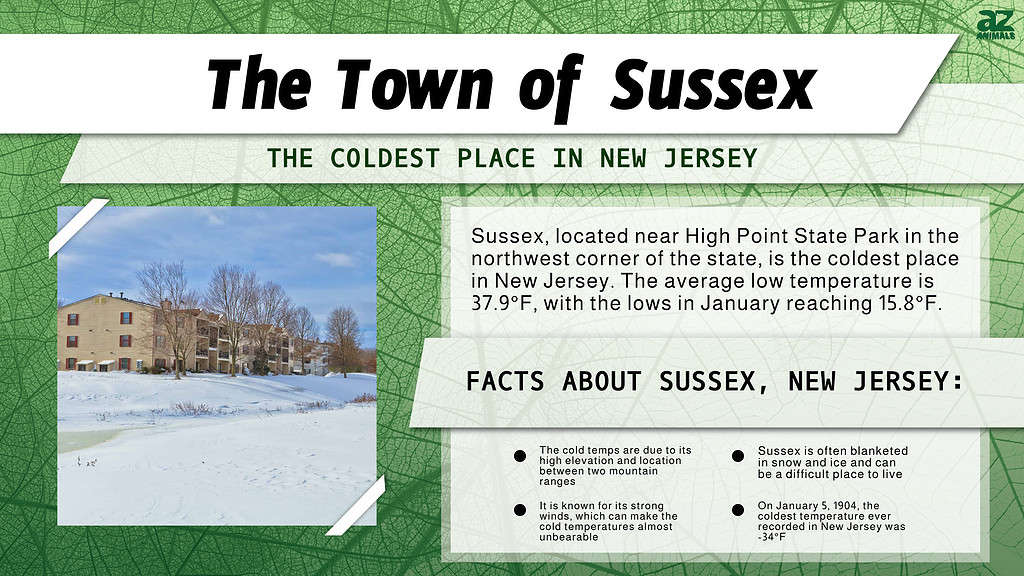New Jersey isn’t one of the coldest places in the United States, but that still doesn’t mean it gets downright freezing during certain points of the year! The state is located in the northeastern portion of the United States and is primarily influenced by the Atlantic Ocean, which it borders. Today, we’re going to look at the weather in New Jersey, particularly the coldest place and the coldest recorded temperature. It may be a bit surprising! Let’s get started.

The Coldest Place in New Jersey
Finding the “coldest” place in any state is a bit tough, especially because it depends on how you measure. Today, we will break it up a bit, starting with the coldest city in New Jersey.
Sussex, New Jersey, is one of the coldest towns in the entire state of New Jersey. Located near High Point State Park in the northwest corner of the state, Sussex is known for its bitterly cold winters. In Sussex, the average low temperature is 37.9 degrees Fahrenheit, with January temperatures typically reaching an average of only 15.8 degrees Fahrenheit. During the summer, temperatures in Sussex can reach up to the mid-80s, but the spring and fall months usually see temperatures in the 50s and 60s. Winter, however, is a different story!

Sussex is known for its strong winds, which can make the cold temperatures quite unbearable.
©iStock.com/andykazie
The cold temperatures in Sussex are caused by its high elevation, as well as its being located in a valley between two mountain ranges. This elevation, combined with the valley’s location, creates a pocket of cold air that is trapped in the town. Nearby, the highest point in all of the state is High Point, a mountain with a rather apt name. This pocket of cold air can make Sussex a difficult place to live in winter. In addition to the cold temperatures, the town is often blanketed in snow and ice. Sussex is also known for its strong winds, which can make the cold temperatures even more unbearable. If you plan on going to Sussex in the winter, a solid coat is essential.
The Coldest Temperature Ever Recorded in New Jersey

©Famartin / CC BY-SA 4.0 – License
On January 5, 1904, River Vale, New Jersey, experienced a record-breaking cold weather event. The temperature plummeted to an astonishing -34 degrees Fahrenheit, a temperature that had never been seen before and has not been seen since. The cold snap only lasted a few days, but it left its mark in the record books; the -34 degree temperature remains the lowest ever recorded in New Jersey. To this day, it stands as a reminder of just how cold New Jersey winters can be.
River Vale, New Jersey, is located in Bergen County and is bordered by the towns of Hillsdale, Westwood, and Washington Township.
The Cold-Hardy Wildlife of New Jersey

You can find white-tailed deer in New Jersey.
©Paul Tessier/Shutterstock.com
New Jersey has a wide variety of wildlife, including white-tailed deer, wild turkey, and eastern white pine. Each has adapted unique strategies that enable them to survive the warm summers and bitter winters that the northeast has each year.
Animals
The white-tailed deer is probably the most well-known of the three and can be found throughout the state. It is a large member of the deer family with a reddish brown coat and a white tail (hence the name). It is an herbivore, feeding on grasses and other vegetation. During the cold winter months, the deer can be seen gathering in herds in open fields and woodlands, seeking shelter from the cold. Their fur also has hollow guard hairs with an undercoat that keeps them well insulated, as can be seen from the snow that often sits on their backs and doesn’t melt.
Wild turkeys are well-equipped to survive the winter. They have thick, insulating feathers that help them stay warm, and their feet and legs are covered in feathers that help them stay dry. Turkeys also become more active during the colder months, which helps keep them warm. Additionally, wild turkeys also take shelter in thickets and forests to stay warm and dry or roost in tree cavities to keep out of the wind and snow.
Trees
The eastern white pine is an evergreen tree native to North America and is one of the most widespread coniferous trees in the region. It has evolved to survive the cold and harsh winters of the region by developing a thick layer of bark and specialized needles that act as an insulating layer. The needles are covered in a thick wax-like coating that helps them to retain their moisture, while the bark helps to protect the tree from freezing temperatures and wind. The eastern white pine also produces a type of antifreeze, which helps to prevent its cells from freezing and bursting.
Up Next:
- Discover the Coldest Place in California
- The Top 10 Coldest U.S. States
- Discover the Coldest Point of the Mississippi River
The photo featured at the top of this post is © FotosForTheFuture/Shutterstock.com
Sources
- National Oceanic and Atmospheric Administration, Available here: https://www.ncei.noaa.gov/access/monitoring/scec/records
Thank you for reading! Have some feedback for us? Contact the AZ Animals editorial team.






